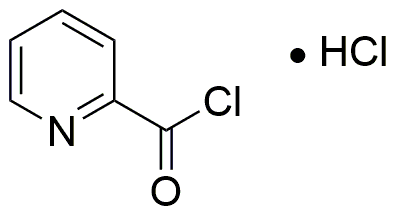Pyridine-2-carbonyl chloride hydrochloride is widely utilized in research focused on:
- Synthesis of Pharmaceuticals: This compound serves as a key intermediate in the synthesis of various pharmaceutical agents, enhancing the efficiency of drug development processes.
- Agrochemical Production: It is used in the formulation of agrochemicals, providing effective solutions for pest control and crop protection, which is crucial for agricultural productivity.
- Organic Synthesis: Researchers leverage its reactivity in organic synthesis, allowing for the creation of complex molecules that are essential in materials science and chemical research.
- Laboratory Reagent: As a versatile reagent, it is employed in various laboratory applications, facilitating experiments in chemical analysis and synthesis.
- Development of Specialty Chemicals: The compound is instrumental in producing specialty chemicals, which are tailored for specific applications in industries such as cosmetics and food processing.
General Information
Properties
Safety and Regulations
Applications
Pyridine-2-carbonyl chloride hydrochloride is widely utilized in research focused on:
- Synthesis of Pharmaceuticals: This compound serves as a key intermediate in the synthesis of various pharmaceutical agents, enhancing the efficiency of drug development processes.
- Agrochemical Production: It is used in the formulation of agrochemicals, providing effective solutions for pest control and crop protection, which is crucial for agricultural productivity.
- Organic Synthesis: Researchers leverage its reactivity in organic synthesis, allowing for the creation of complex molecules that are essential in materials science and chemical research.
- Laboratory Reagent: As a versatile reagent, it is employed in various laboratory applications, facilitating experiments in chemical analysis and synthesis.
- Development of Specialty Chemicals: The compound is instrumental in producing specialty chemicals, which are tailored for specific applications in industries such as cosmetics and food processing.
Documents
Safety Data Sheets (SDS)
The SDS provides comprehensive safety information on handling, storage, and disposal of the product.
Product Specification (PS)
The PS provides a comprehensive breakdown of the product’s properties, including chemical composition, physical state, purity, and storage requirements. It also details acceptable quality ranges and the product's intended applications.
Certificates of Analysis (COA)
Search for Certificates of Analysis (COA) by entering the products Lot Number. Lot and Batch Numbers can be found on a product’s label following the words ‘Lot’ or ‘Batch’.
*Catalog Number
*Lot Number
Certificates Of Origin (COO)
This COO confirms the country where the product was manufactured, and also details the materials and components used in it and whether it is derived from natural, synthetic, or other specific sources. This certificate may be required for customs, trade, and regulatory compliance.
*Catalog Number
*Lot Number
Safety Data Sheets (SDS)
The SDS provides comprehensive safety information on handling, storage, and disposal of the product.
DownloadProduct Specification (PS)
The PS provides a comprehensive breakdown of the product’s properties, including chemical composition, physical state, purity, and storage requirements. It also details acceptable quality ranges and the product's intended applications.
DownloadCertificates of Analysis (COA)
Search for Certificates of Analysis (COA) by entering the products Lot Number. Lot and Batch Numbers can be found on a product’s label following the words ‘Lot’ or ‘Batch’.
*Catalog Number
*Lot Number
Certificates Of Origin (COO)
This COO confirms the country where the product was manufactured, and also details the materials and components used in it and whether it is derived from natural, synthetic, or other specific sources. This certificate may be required for customs, trade, and regulatory compliance.


